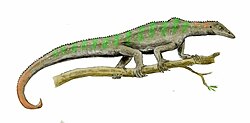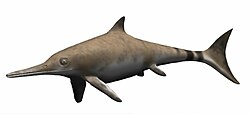Sauropterygia
The Sauropterygia was a superorder of successful aquatic reptiles that flourished during the Mesozoic era. They are united by an adaptation of their shoulder, designed to support powerful paddle strokes. Some later sauropterygians like the pliosaurs developed a similar mechanism in their pelvis.[1]
| Sauropterygia Temporal range: Lower Triassic – Upper Cretaceous
| |
|---|---|

| |
| The pliosaur Kronosaurus hunts a plesiosaur: by Dmitry Bogdanov. | |
| Scientific classification | |
| Kingdom: | |
| Phylum: | Chordata
|
| Class: | |
| Superorder: | †Sauropterygia Richard Owen, 1860
|
Origins and evolution
The earliest sauropterygians appeared about 245 million years ago, at the start of the Triassic period. At first they were small, less than a metre. They were semi-aquatic lizard-like animals with long limbs (called pachypleurosaurs). They developed into a group called the nothosaurs, several meters long. The sauropterygians included another very distinctive group: the placodonts. They were bottom-feeders on shellfish, and possessed flat, crushing teeth to handle their prey.[1]p148–151
The end-Triassic extinction event wiped them all out except for the plesiosaurs. During the earliest Jurassic these diversified quickly into the long-necked small-headed plesiosaurs proper, and short-necked large-headed pliosaurs.
Orders
Position uncertain
Sauropterygia Media
References
Other websites
- A review of the Sauropterygia Archived 2007-07-06 at the Wayback Machine. Adam Stuart Smith. The Plesiosaur Directory. Retrieved April 17, 2006.
- Paleofile taxalist - lists every species and synonyms. Retrieved February 26, 2006







